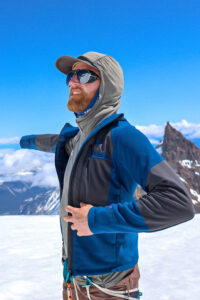June 2, 2024
On our IMG blog, we’re endeavoring to answer the most frequently asked questions we get in hopes of sharing answers and tricks of the trade with as many people as possible! First on the list is about your eyes- both eyewear and eye care!
When talking about rescues, many responders will use the phrase ‘life, limb, or sight’ to determine the need for an expeditious evacuation if there are threats to any of those three items. Since threats to a climber’s eyes is considered an immediate threat, it’s important that you take care of your eyes and make sure that you invest in the proper gear to keep your eyes healthy in the mountain environment.
Snowblindness is a very painful, but completely preventable occurrence for people who don’t wear proper eye protection in the mountains. The reflectivity of the snow and the increased UV at higher altitudes put climbers and skiers at increased risk. To prevent this from occurring, it is imperative that you invest in quality glacier glasses. Glacier glasses differ from sunglasses in two ways: the darkness of the lens and the shape of the glasses. You want to get a pair of glacier glasses that have a Category 4 lens. “Cat 4” lenses block 92% (or more) of the light, preventing snowblindess in mountain environments. Some popular and trusted options for glacier glasses with Cat 4 lenses are the Julbo Explorers, Julbo Camino, or the Smith Embark. If you’re on an IMG program based in Washington, we have Cat 4 glacier glasses available to rent. Did you know that Cat 4 lenses are so dark that you shouldn’t drive in them?
Glacier glasses should also protect your eyes on the sides, any light that might leak in from the sides can also cause snowblindness even when wearing sunglasses. That’s why many of the glasses made specifically for mountaineering come with built-in side shades or the lens wraps around to the side as seen in the Julbo Explorers. If you have a pair of glasses that are dark enough but don’t wrap to protect your eyes, don’t fret. You can make little flaps of duct tape to cover the sides of your glasses! This is a common budget fix we see frequently in the outdoors.
Let’s talk about prescription glasses and contacts. If you have the means to invest in a prescription pair of glacier glasses, you’re golden. You can either send your prescription to glasses manufacturers directly or you can buy a pair of frames and bring them to your optometrist to make custom lenses for you. If you wear glasses, it’s also a good idea to bring with you a spare pair of glasses as well as a pair of goggles that can fit over your frames in case all else fails!
Contacts are a fine option for vision correction in the mountain environment if you’re already an experienced contact-wearer. If you go with contacts, you’ll need to be diligent keeping up with your eye hygiene. Make sure you have glasses as a back up! Many people who use contacts also will bring a pair of light-lenses goggles. On Mt. Rainier, it can get windy and dusty during the summit attempt. The light lenses in the goggles are perfect for climbing at night and keeping dirt out of your eyes!
If you have questions about the best eyewear system for you, don’t hesitate to reach out to our office! We’re equipped to answer any questions you may have.

